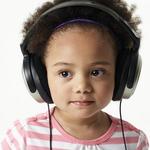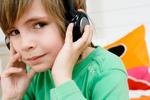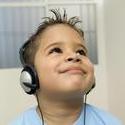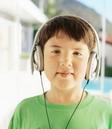|
| |
Headphone & Noise Cancelling Device Precautions After AIT

Contact Us
Complete
On-line AIT Checklist
The AIT
protocol processes and filters music for a therapeutic outcome.
Using a special device that can't go above safe hearing levels, so wearing headphones during the Berard
AIT listening sessions will not cause any harm.
About The Headphones Used
For Berard AIT
-
In
Berard AIT,
the headphones used are of a superlative quality.
These headphones are expensive, recording studio headphones,
with a good impedence at the top of the range of headphones for
acoustic precision.
-
The music
played back via an AIT device is electronically modulated.
The person never hears the full musical (frequency) spectrum -
high and low broad band filters remove either of these randomly.
The music intensity is vastly different to
listening to music
on headphones recreationally.
-
When a person
undergoes Berard AIT,
the music levels are determined by means careful attention to the client's comfort levels.
-
No settings are above 80 dB's output and
so the person is
protected against damage to the auditory system due to sudden
excessive changes in loudness levels.
-
Recreational music
from headphones isn't the same. People often tolerate
music far louder through headphones than through free-field
listening. One of the top manufacturers of headphones
internationally, Beyerdynamic, places warnings to that effect on
their equipment packaging, which states that listening to music
through these headphones at levels louder than 80 dB's will
cause irreversible hearing loss.
-
No child has
adequate audiological knowledge to know when music is "too
loud" and when the headphones are on, so parents must check
sound levels when allowing a child to use headphones at any
time.
|
-
We
recommend that headphones not be used for listening to music
for about 6 months post AIT.
-
The
use
of headphones for audiological testing, educational tapes, books on
tape, academic lessons on computers with spoken words is permissible.
-
Important Note: Do
not allow headphones to be used by a child for listening to music,
unless it is done at at a safe level, below 80 db. Parents must
check the volume BEFORE allowing a child to use headphones. Parents and professionals
must be cautious about headphone use for music since
it has been reported that listening repeatedly to
loud music with headphones
can have a negative impact on AIT results.
-
If headphones are needed in certain
situations (such as while driving in the car, or for viewing the movie on an airplane, try putting
the headphones around the neck and turning up the volume
to a level that can be heard by the listener. This allows the sounds to be carried
to the auditory system through the atmosphere, which is the way the
ear is designed to work.
-
The direct volume level that is
unmoderated by environmental sound has distorting effects on the ear. Do your best to avoid loud rock concerts,
or loud parties and use ear plugs temporarily
at that event if there will be extended exposure.
Long term exposure to loud extended music in a disco or rock concert is
considered to be in the
dangerous category for hearing.
Noise Cancelling Headphone Use
Before And After AIT
We recommend to parents that they
do what they need to do until
AIT, but then wean the
child OFF the ear plugs or noise canceling headphones, except in situations
where we would want to protect any normal listener such as during loud
performances, fireworks, etc.
-
From what we know about the low levels of the
brain, mainly the brain stem level systems for noise suppression, is that in the
case of noise cancelling headphones, they are kept functioning by
minute-to-minute daily use. For example, using earplugs to damping noise so we
can sleep.
-
But it is a little like a muscle: use it or lose it.
The best
research along these lines is for much more severe auditory deprivation than
mere addiction to noise suppression gear. Research is done on children with severe,
chronic, long standing middle ear (conductive) hearing loss.
-
It has also been studied in lab mice that were
purposely deprived of sound for crucial days of development. In the mice where
one could look at structures, many brain stem cell systems were under-developed
compared to the normal-hearing mice.
-
With hyperacusis or hypersensitive
hearing, we have the added problem of the person's damping defense against noise
which means the stiffening of the cochlear hair cells to temper the sound coming
in, which causes the depressions in the
audiogram
or Listening Test or
"greater hearing loss", when not using the ear protectors.
Dangers of Excessive Headphone Use in General
|
Ron Eavey, director of pediatric
otolaryngology at Massachusetts Eye and Ear Infirmary states:
"Using earphones for hours at high volumes basically causes '"shock and
awe" to delicate hair-like cells deep within the inner ear that help the
brain process sound...
After
years of abuse, those structures won't function anymore." |
|
Dr.
Berard stressed that headphones for loud music should not be used after doing
his AIT method.
Headphones are typically used for personal
listening, while the average listener plays the volume too loudly.
Dr.
Berard's concern remains with the health of the middle ear, the quality
of the headphones - and most of all the intensity of the sound coming
from the headphones.
Dr. Berard
describes the impact as follows: "After
AIT, excessively loud volume delivered by headphones
may cause a disruption in the balance established. Without headphones,
the ear canal works like a shock absorber. The eardrum is the second shock
absorber, and the ossicles are the third shock absorber, all protecting
the cochlea. With headphones, sounds go directly to the eardrum, thereby
taking away the first protector, allowing sound to attack the cochlea
more directly. The headphones per se, do not cause regression after treatment. The
intensity level of the excessive volume input from the headphones
causes the impact on the acoustic reflex, which in turn directly impacts
the cochlea."
|
|
"From the moment I became interested
in the problems of hearing, I have been aware of the studies by the health
organizations concerning hearing deficiencies caused by wearing headphones
for certain occupations.
The statistics were related to telephone operators, translators,
and musicians, and even though I cannot exactly quote the results now,
I remember that the people whose hearing had been impaired through occupationally-related
causes could obtain an official pension. Thus, it was officially recognized
that wearing headphones to listen to speech or music could lead to some
hearing damage. Afterwards I was asked by several lawyers to evaluate
the percentage of hearing loss of these individuals. This percentage was
very different for each person, probably because of differences in the
physiological and physical resistance of each person.
If it was admitted that wearing headphones to listen
to speech or music could lead to some damage to normal individuals, it
is obvious that someone who had been treated with
AIT, who had some problem of hearing,
would be more
sensitive to all hearing aggressions, including wearing headphones. This
is the reason why I forbid the use of headphones, or at least, if people
have to do this because of their work, to minimize the amount of time
for this use." |
Hearing Problems And
Headphone Use
|
Normally, when you hear sounds, such
as music, talking, noises from your own behavior, songs of the birds, as
well as thunderclaps, any kinds of engines or of explosions, they reach
your tympanic drums after passing through a large quantity of
atmosphere. This air works as a shock absorber to diminish the intensity
of the impact on the eardrum.
However, when you are hearing sounds coming
directly from the membrane of the headphone to your tympanic membrane,
through the one square centimeter of air included in your outer ear
canal, the impact is practically direct, without any possibility of
easing this aggression.
This constant aggression is
transmitted to the ossicles, then to the inner ear.
This explains why many of people working with headphones have a trough,
or drop on 4000 Hertz on their
Audiogram or
Listening Test,
similar to that of people working in noisy factories.
On the other hand, wearing headphones
eliminates all the sounds coming from outside,
increasing the sounds coming from your own body, your own voice,
creating a sort of echo. This aspect of the problem is more important
for people wearing earplugs placed directly in the outer ear canal close
to the eardrum. Then there is no more air to help the vibration of the
tympanic drum and all your own sounds lead directly to the cochlea and
the brain, which is not satisfactory, physiologically or
psychologically. |
| |
|







